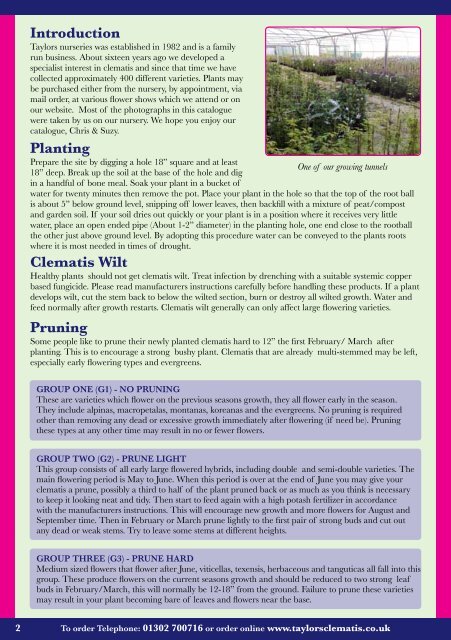Catalogue Growing Guide - Taylors Clematis
Catalogue Growing Guide - Taylors Clematis
Catalogue Growing Guide - Taylors Clematis
You also want an ePaper? Increase the reach of your titles
YUMPU automatically turns print PDFs into web optimized ePapers that Google loves.
2<br />
Introduction<br />
<strong>Taylors</strong> nurseries was established in 1982 and is a family<br />
run business. About sixteen years ago we developed a<br />
specialist interest in clematis and since that time we have<br />
collected approximately 400 different varieties. Plants may<br />
be purchased either from the nursery, by appointment, via<br />
mail order, at various flower shows which we attend or on<br />
our website. Most of the photographs in this catalogue<br />
were taken by us on our nursery. We hope you enjoy our<br />
catalogue, Chris & Suzy.<br />
Planting<br />
Prepare the site by digging a hole 18” square and at least<br />
One of our growing tunnels<br />
18” deep. Break up the soil at the base of the hole and dig<br />
in a handful of bone meal. Soak your plant in a bucket of<br />
water for twenty minutes then remove the pot. Place your plant in the hole so that the top of the root ball<br />
is about 5” below ground level, snipping off lower leaves, then backfill with a mixture of peat/compost<br />
and garden soil. If your soil dries out quickly or your plant is in a position where it receives very little<br />
water, place an open ended pipe (About 1-2” diameter) in the planting hole, one end close to the rootball<br />
the other just above ground level. By adopting this procedure water can be conveyed to the plants roots<br />
where it is most needed in times of drought.<br />
<strong>Clematis</strong> Wilt<br />
Healthy plants should not get clematis wilt. Treat infection by drenching with a suitable systemic copper<br />
based fungicide. Please read manufacturers instructions carefully before handling these products. If a plant<br />
develops wilt, cut the stem back to below the wilted section, burn or destroy all wilted growth. Water and<br />
feed normally after growth restarts. <strong>Clematis</strong> wilt generally can only affect large flowering varieties.<br />
Pruning<br />
Some people like to prune their newly planted clematis hard to 12” the first February/ March after<br />
planting. This is to encourage a strong bushy plant. <strong>Clematis</strong> that are already multi-stemmed may be left,<br />
especially early flowering types and evergreens.<br />
GROUP ONE (G1) - NO PRUNING<br />
These are varieties which flower on the previous seasons growth, they all flower early in the season.<br />
They include alpinas, macropetalas, montanas, koreanas and the evergreens. No pruning is required<br />
other than removing any dead or excessive growth immediately after flowering (if need be). Pruning<br />
these types at any other time may result in no or fewer flowers.<br />
GROUP TWO (G2) - PRUNE LIGHT<br />
This group consists of all early large flowered hybrids, including double and semi-double varieties. The<br />
main flowering period is May to June. When this period is over at the end of June you may give your<br />
clematis a prune, possibly a third to half of the plant pruned back or as much as you think is necessary<br />
to keep it looking neat and tidy. Then start to feed again with a high potash fertilizer in accordance<br />
with the manufacturers instructions. This will encourage new growth and more flowers for August and<br />
September time. Then in February or March prune lightly to the first pair of strong buds and cut out<br />
any dead or weak stems. Try to leave some stems at different heights.<br />
GROUP THREE (G3) - PRUNE HARD<br />
Medium sized flowers that flower after June, viticellas, texensis, herbaceous and tanguticas all fall into this<br />
group. These produce flowers on the current seasons growth and should be reduced to two strong leaf<br />
buds in February/March, this will normally be 12-18” from the ground. Failure to prune these varieties<br />
may result in your plant becoming bare of leaves and flowers near the base.<br />
To order Telephone: 01302 700716 or order online www.taylorsclematis.co.uk



